
table of contents
- Basics
- Bushes with black flowers from B to D
- Bushes with black flowers from G to L.
- Bushes with black flowers from P to S
- frequently asked Questions
Bushes with black flowers are in great demand. They set unique accents in gardens and on balconies. The following list includes the best specimens with different properties that offer something for every requirement.
In a nutshell
- There are no pure black flower colors in nature, they go maximally in this direction
- black flower colors give bushes a noble elegance
- Shrubs from the list are easy to cut
- many shrubs are also suitable for cultivation in pots
Basics
The black flowers are just the first perception. In fact, they seem like that, but they are not. There are only a few with almost black flowers among the bushes. Mostly they have deep dark red, dark blue, dark purple nuances that go strongly into the black and therefore appear that way.
Bushes with black flowers from B to D
Beard flower "Kew Blue" (Caryopteris clandonensis "Kew Blue")
- Upright, bushy subshrub
- Family: Mint family (Lamiaceae)
- Height: up to 80 centimeters
- Flower: dark blue to black-blue, arranged in clusters
- Flowering period: July to September
- Location: Sunny, sheltered from the wind
- Soil: moderately moist, not too heavy, well-drained, pH value: neutral
- Special features: bee-friendly, hardy, cold protection recommended in case of severe frost
Beard flower "Blue Sparrow" (Caryopteris clandonensis "Blue Sparrow")
- Shrub to subshrub
- Family: Mint family (Lamiaceae)
- Height: 60 to 70 centimeters
- Spread: 70 to 90 centimeters
- Flower: dark blue to black-blue, simple
- Flowering period: July to October
- Location: sunny
- Soil: permeable, normal garden soil, pH value: between weakly alkaline and weakly acidic
- Special features: Fragrant leaves, bee-friendly, very richly blooming, tolerant of lime, conditionally frost-hardy, protection against the cold recommended in frosty conditions
Black Baccara rose shrub (Rosa hybrid "Black Baccara")
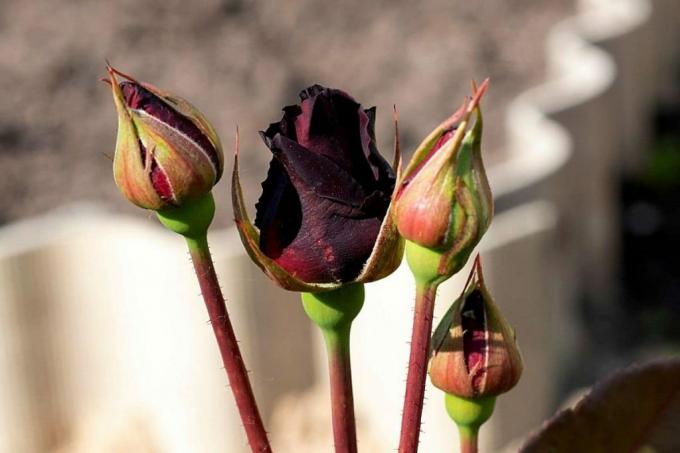
- Darkest Rose varietywhich is currently available worldwide
- Grows into a small shrub
- Family: Rosaceae
- Height: 50 to 60 centimeters, rarely up to 100 centimeters
- Spread: 40 to 50 centimeters
- Blossom: velvety-burgundy, red-black
- Flowering period: Twice - in early summer around June and late summer in late August / early September
- Location: Sunny, tolerates partial shade, protected from rain
- Soil: rich in nutrients, deep, loose, pH value: between slightly alkaline and slightly acidic
- Special features: very durable as a cut flower, shimmering pitch black, subtle fragrance, low to moderate maintenance requirements
Dahlia 'Kenora Macob' Dinner Plate (Dahlia)

- Shrub-like growth, XL dahlia
- Family: Asteraceae
- Height: 90 to 100 centimeters
- Deep red to black flowers
- Flower diameter up to 20 centimeters
- Flowering period: July to October
- Location: full sun, warm
- Soil: Well-drained, humus garden soil, pH value: slightly acidic around 6.5
- Special features: Very sensitive to frost, ideal container plant
Bushes with black flowers from G to L.
Garden scabiosa (Scabiosa atropurpurea "Black knight")

- Bush-like growth due to strong branches near the ground
- Family: Asteraceae
- Height: 60 to 80 centimeters
- Dark purple-black flower
- Flowering period: July to October
- Location: sun
- Soil: rich in nutrients, water-permeable, not too moist, pH value: slightly acidic to neutral
- Special features: Annual plant, as Cut flower popular, ideal for flower beds and pots
Double Columbine "Black Barlow" (Aquilegia vulgaris hybrid "Black Barlow")

- Shrub-like growing perennial
- Family: Buttercup Family (Ranunculaceae)
- Height: 60 to 80 centimeters
- Flower: purple-black filling, bell-shaped
- Flowering period: May to July
- Location: sunny, shady, partial shade
- Soil: Fresh, well-drained, humus soil, not too dry, pH value: moderately acidic to mildly alkaline
- Special features: Easy to care for, very easy on cutting, extremely hardy, also ideal for planting in pots
Italian clematis 'Black Prince' (Clematis viticella 'Black Prince')
- Shrubby climber
- Family: Buttercup Family (Ranunculaceae)
- Height: 300 to 400 centimeters
- Flower: black-violet, purple-black, double
- Flowering period: July to September
- Location: Sun to partial shade, warm
- Soil: humic, nutrient-rich and well-drained, pH value: acidic around 5.0
- Special features: florid, robust, very hardy, noble appearance
Climbing shrub rose 'Senegal' (Rosa 'Senegal')
- Shrubby Climbing plant
- Family: Rosaceae
- Height: 200 to 300 centimeters
- Flower: black-red, purple-black
- Flowering period: June to July, often additional autumn flowering
- Location: sun to partial shade
- Soil: rich in nutrients, well drained, pH value: neutral to slightly acidic
- Special features: Strong and fast-growing, elegant appearance, insensitive to diseases, hardy, pleasantly scented
Lenten rose "Midnight Ruffles" (Helleborus orientalis hybrid "Midnight Ruffles")
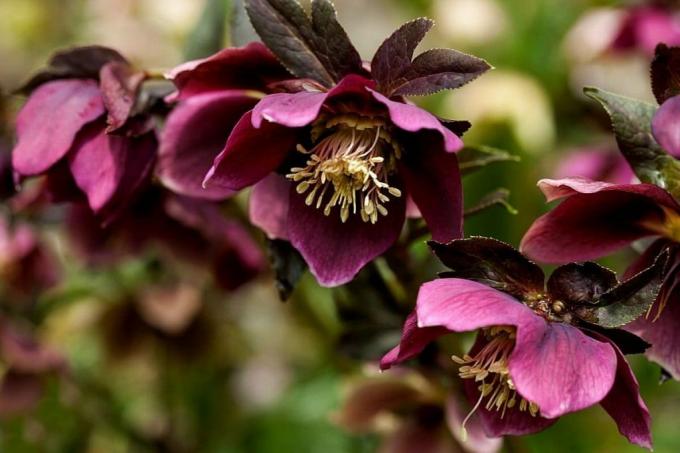
- Also known as oriental hellebore (Helleborus orientalis)
- Flat, shrub-like growth without climbing aid - with climbing aid climbing plant
- Family: Buttercup Family (Ranunculaceae)
- Height: 90 to 100 centimeters
- Flower: red-black
- Flower diameter up to 20 centimeters
- Flowering period: January / February to April / May
- Location: partial shade
- Soil: Calcareous, water-permeable, humus-rich, deep garden soil, pH value: neutral to slightly alkaline
- Special features: undemanding, three times more petals than colorful spring roses, early bloomers, very hardy, ideal for planting in pots and containers, caution: poisonous
Bushes with black flowers from P to S
Persian Imperial Crown (Fritillaria persica)
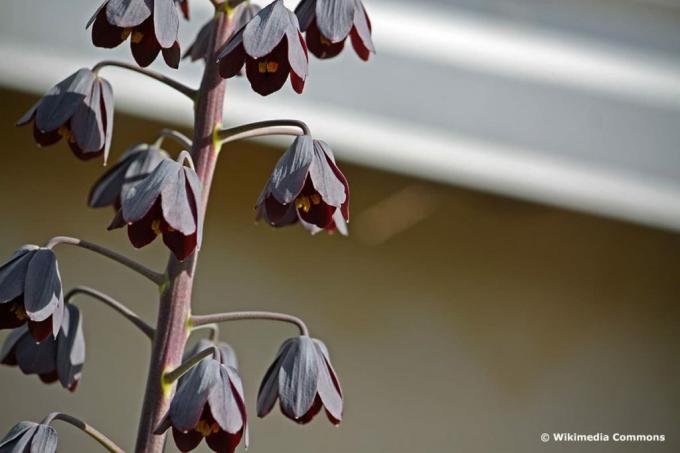
- Also called the Persian bell lily
- Family: Lily family (Liliaceae)
- Upright, loose, growing like a shrub
- Height: 80 to 100 centimeters
- Blossom: red-brown to red-black, dark-aubergine-colored, inverted funnel shape
- Flowering period: between April and May
- Location: sunny
- Soil: permeable to water, loose, dry, pH value: acidic, calcareous
- Special features: Winter hardy, but protect new shoots from the cold in late frosts
Chocolate Cosm (Cosmos atrosanguineus)
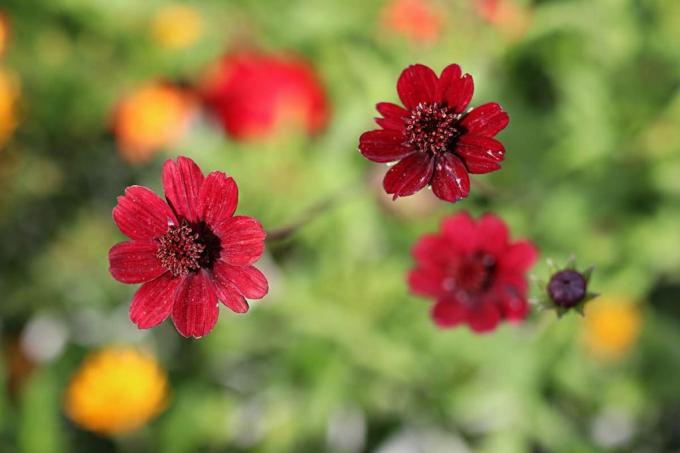
- Also called the black cosm
- Perennial, herbaceous upright growing rhizome to subshrub
- Family: Asteraceae
- Height: 40 to 60 centimeters
- Flower: black-brown
- Flowering period: from July to October
- Location: sunny, sheltered
- Soil: permeable to water, rich in nutrients, evenly moist, pH value: moderately acidic
- Special features: Smells of dark chocolate, should be wintered in a dark and frost-free environment
Black and red hollyhock (Alcea rosea var. nigra 'Erfurt')

- Subshrub
- Family: Mallow family (Malvaceae)
- Upright, loose, growing like a shrub
- Height: 180 to 200 centimeters
- Flower: red-black, almost black, bowl-shaped
- Flowering period: between July and August
- Location: Full sun to sunny
- Soil: nutrient-rich, well-drained, loose, dry, pH value: acidic or calcareous
- Special features: one to two year old variety, hardy
Black Deadly Nightshade (Atropa belladonna)
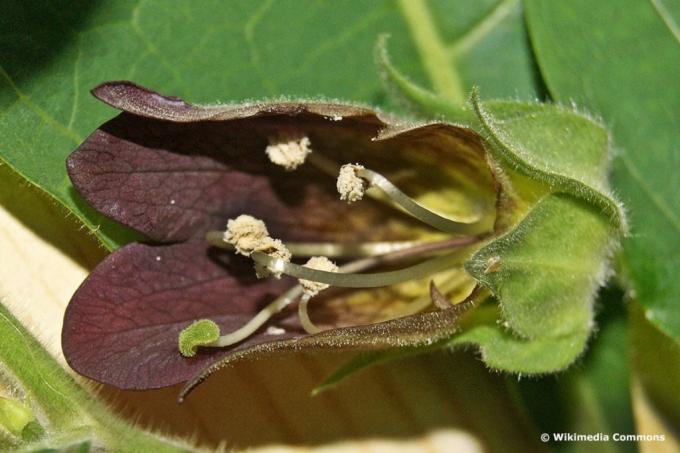
- Also known as sleeping cherry, devil cherry and wolfberry
- Shrub-like habit, heavily branched
- Family: Nightshade family (Solanaceae)
- Height: 50 to 150 centimeters, rarely up to 200 centimeters
- Blossom: brown-violet, brown-black-violet
- Flowering period: between June and August
- Fruits: initially green, later black - be careful: very poisonous!
- Location: partial shade
- Soil: rich in nutrients, calcareous, like, porphyry and gneiss soil, pH value: between 7.5 and 8.5
- Special features: smell of broken roots very penetrating and unpleasant, risk of confusion with edible cherries, which is why poisoning often occurs, hardy
frequently asked Questions
Not all. Some shrubs are a special breed, others naturally have plenty of anthocyanins as secondary plant material. In the latter case, this ensures dark flower colors, as in the case of the deadly nightshade, for example. In the case of hybrids, the shrubs are usually bred in such a way that they produce significantly more anthocyanins and therefore reach into the black.
Yes and no. According to the WHO, the secondary and water-soluble plant substance "anthocyanins" is actually toxic. However, this is so low that no symptoms of poisoning or other health consequences are to be expected. Anthocyanins are also used, for example, in the production of food coloring, for which there are no restrictions on the amount of coloring matter to date.
Bushes with black flowers can be combined with all plants in the bed or on the balcony that have the same demands on the location and the soil. From a color point of view, however, light-colored flowering plants are particularly good as neighbors because thus the noble appearance of the unusually dark flowering shrubs is particularly effective comes.
No. Black flowering shrubs are no more susceptible to disease than lighter varieties. In the case of hybrids it is actually the opposite, because in targeted breeding there is a focus on “drawing on” more robust properties and less susceptibility to typical diseases.



